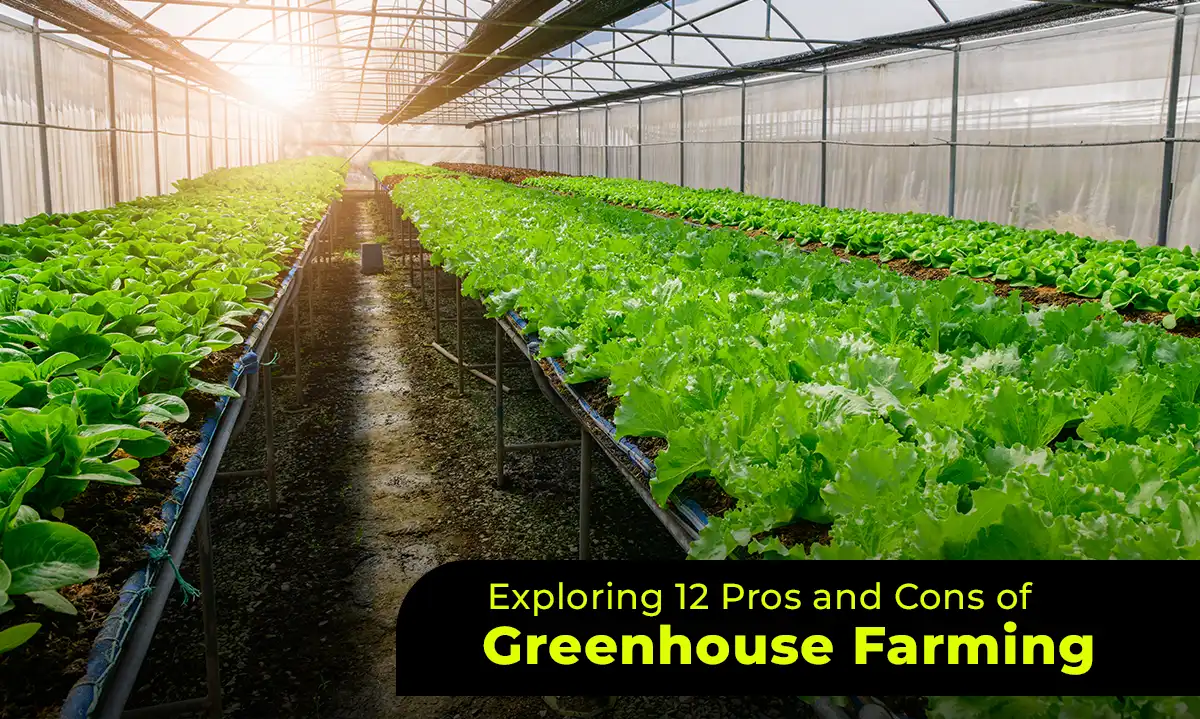Exploring 12 Pros and Cons of Greenhouse Farming

Greenhouse farming, often referred to as controlled environment agriculture (CEA), has gained significant traction in recent years as a sustainable solution to meet the growing demand for food while minimizing environmental impact. As the world grapples with issues like climate change and food security, greenhouse farming emerges as a promising avenue. Let's delve into the 12 pros and cons of this innovative agricultural practice.
Pros:
Year-Round Production: Greenhouses provide a controlled environment, allowing for year-round cultivation regardless of external weather conditions. This ensures a consistent and reliable food supply.
Higher Yield: With optimal growing conditions such as regulated temperature, humidity, and light, greenhouse crops often yield higher compared to traditional open-field farming.
Water Efficiency: Greenhouse farming utilizes advanced irrigation systems that optimize water usage, reducing consumption compared to conventional farming methods. This is especially important in areas where water is scarce.
Pest and Disease Control: Enclosed structures of greenhouses offer protection against pests and diseases, minimizing the need for chemical pesticides and promoting healthier crops.
Space Utilization:Vertical greenhouse farming techniques maximize space utilization by stacking crops vertically, enabling higher productivity in limited areas and making it suitable for urban environments.
Quality Control: The controlled environment of greenhouses enables precise management of factors like temperature, humidity, and CO2 levels, ensuring consistent quality and flavor of produce.
Extended Growing Season: By manipulating environmental conditions, greenhouse farming extends the growing season for crops that may not thrive in certain climates, diversifying crop options.
Reduced Environmental Impact:Greenhouse farming reduces the carbon footprint associated with traditional agriculture by minimizing water usage, pesticide application, and transportation emissions.
Job Creation: The adoption of greenhouse farming creates employment opportunities in various sectors, including construction, technology, maintenance, and agriculture.
Crop Diversification: Greenhouses allow farmers to grow a wide range of crops, including fruits, vegetables, herbs, and flowers, enabling diversification and reducing dependency on single crops.
Local Food Production: By establishing greenhouses closer to urban centers, fresh produce can be supplied locally, reducing the need for long-distance transportation and supporting local economies.
Adaptability to Climate Change: Greenhouses offer resilience against climate change by providing a controlled environment and protecting crops from extreme weather events and temperature fluctuations.
Cons:
High Initial Investment: Setting up a greenhouse farm requires significant upfront investment in infrastructure, technology, and equipment, which may deter small-scale farmers.
Energy Consumption: Maintaining optimal conditions within greenhouses demands energy for heating, cooling, and lighting, leading to high energy consumption, especially in colder climates.
Technical Expertise:Operating a greenhouse effectively requires specialized knowledge in areas such as climate control, irrigation, and crop management, posing a barrier for inexperienced farmers.
Dependency on Technology: Greenhouse farming heavily relies on technology and automation for monitoring and controlling environmental factors, making the system vulnerable to technical glitches and failures.
Risk of Crop Failure: Despite controlled conditions, greenhouse crops are still susceptible to diseases, pests, and environmental fluctuations, posing risks of crop failure.
Limited Crop Variety: While greenhouses offer versatility, certain crops may not thrive in controlled environments, limiting the variety of produce compared to open-field farming.
Maintenance Challenges: Greenhouse structures require regular maintenance to ensure optimal functioning, including cleaning, repairing, and replacing components, which can be labor-intensive and costly.
Environmental Concerns: The production of materials like plastics and chemicals used in greenhouse construction and operation raises environmental concerns related to pollution and waste management.
Land Availability: Finding suitable land for greenhouse farming can be challenging, especially in densely populated areas where land is scarce and expensive.
Market Volatility: The success of greenhouse farming is influenced by market demand and pricing fluctuations, posing risks to profitability and financial sustainability.
Regulatory Compliance: Compliance with regulations related to food safety, environmental standards, and labor practices adds complexity and administrative burden to greenhouse operations.
Social Implications: The transition to greenhouse farming may impact traditional farming communities, raising social issues such as job displacement and cultural shifts.
In conclusion, while greenhouse farming offers numerous advantages such as year-round production, higher yields, and environmental sustainability, it also presents challenges including high initial investment, technical complexity, and market volatility. As technology advances and awareness grows, addressing these challenges will be crucial in harnessing the full potential of greenhouse farming to ensure food security and environmental stewardship.
If you're considering venturing into greenhouse farming or looking for greenhouse farmland for sale, it's essential to weigh these pros and cons carefully and seek expert guidance to make informed decisions. Embracing innovative approaches like vertical greenhouse farming can further enhance the efficiency and sustainability of greenhouse operations. Together, let's cultivate a greener future through responsible agricultural practices.
Latest blogs
JOIN OUR COMMUNITY !
Stay connected with Getfarms! Follow us on social media for the latest updates, exclusive offers, and a glimpse into the world of farmhouse living. Join our community today




























